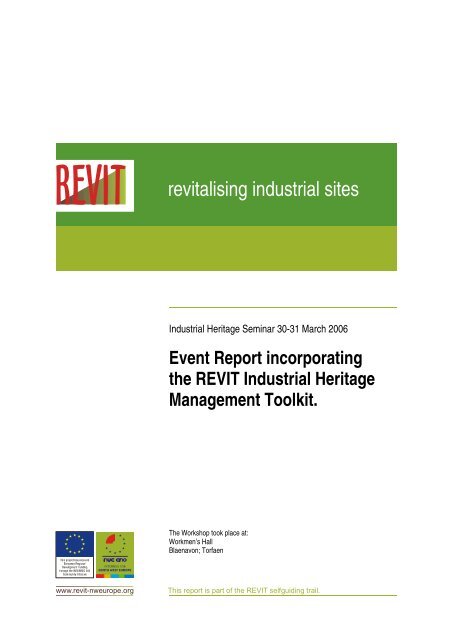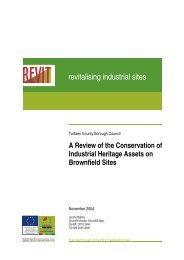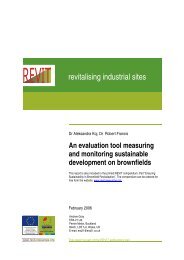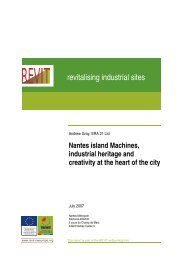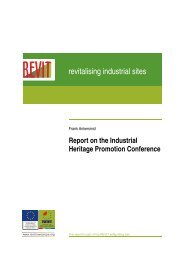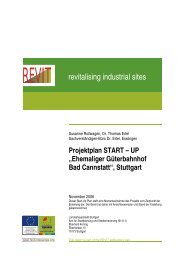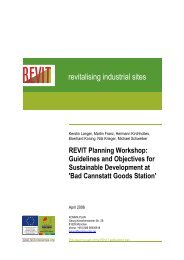Heritage Event Report.pdf - REVIT
Heritage Event Report.pdf - REVIT
Heritage Event Report.pdf - REVIT
You also want an ePaper? Increase the reach of your titles
YUMPU automatically turns print PDFs into web optimized ePapers that Google loves.
<strong>REVIT</strong><br />
revitalising industrial sites<br />
Industrial <strong>Heritage</strong> Seminar 30-31 March 2006<br />
<strong>Event</strong> <strong>Report</strong> incorporating<br />
the <strong>REVIT</strong> Industrial <strong>Heritage</strong><br />
Management Toolkit.<br />
The Workshop took place at:<br />
Workmen’s Hall<br />
Blaenavon; Torfaen<br />
www.revit-nweurope.org<br />
This report is part of the <strong>REVIT</strong> selfguiding trail.
Foreword<br />
The Industrial <strong>Heritage</strong> Seminar that was held on the 30 th and 31 st March was<br />
undertaken as part of the Common Co-operation thematic work of the <strong>REVIT</strong> project<br />
aimed at best practice to preserve and promote Industrial <strong>Heritage</strong> on Brownfield sites.<br />
<strong>REVIT</strong> is an ERDF funded transnational project involving partners from Stuttgart,<br />
Nantes, Tilburg, Hengelo, Medway and Torfaen. Each of the project partners have<br />
different sets of circumstances that they wish to address in terms of industrial heritage<br />
components on their Brownfield Sites and instead of undertaking research directed at<br />
each individual site a two day focused workshop was arranged to address particular<br />
issues and have the benefit of experts, practitioners and ordinary people participate in<br />
debating, providing information and adding value to current knowledge bases. The<br />
following describes these workshops and their outcomes. This should be read not as a<br />
definitive approach – but as a journey and a prompt for ideas that could be used on<br />
other Brownfield projects with a heritage component.<br />
The seminar took place on Thursday 30 and Friday 31 March 2006.<br />
The seminar agenda was developed to address the interests and needs of the <strong>REVIT</strong><br />
partners, who had been involved in setting the topics for the guest presentations and<br />
discussions.<br />
Professor Tom Pritchard was the guest keynote speaker for the dinner reception, which<br />
was held at Llancaiach Fawr (hyperlink to Llancaiach Fawr and to the <strong>Heritage</strong> Works<br />
<strong>pdf</strong>). Professor Pritchard is the Chairman of the Environmental Protection Committee of<br />
the National Assembly for Wales and has been involved in heritage protection and<br />
management for many years, having served as the UK Deputy Chair for the <strong>Heritage</strong><br />
Lottery Fund until his recent retirement.<br />
Workshops<br />
There were four two-hour sessions of workshop-style discussion groups, during which<br />
smaller groups of delegates were able to explore a topic in more depth.<br />
Exhibition<br />
The exhibition of delegates’ and sponsors’ information featured companies and<br />
organisations with relevance to heritage and industrial sites (hyperlink to list of<br />
exhibitors and their contact details).<br />
Photographic competition<br />
As part of the overall event, the Countryside Section of Torfaen County Borough<br />
Council had organised a photo competition to interpret the Blaenavon World <strong>Heritage</strong><br />
Site.<br />
Site visits<br />
There were a number of guided tours to attractions and sites in the area, including the<br />
Big Pit National Mining Museum (www.museumwales.ac.uk/en/bigpit) and Blaenavon<br />
Booktown (www.booktownblaenafon.com).<br />
2
Thursday diary<br />
The two-day event was designed to encourage an exchange of expertise and ideas<br />
from across the UK and Europe with regard to preserving and promoting industrial<br />
heritage. It is an element of a wider programme – <strong>REVIT</strong> –, which aims to create<br />
European partnerships for regenerating industrial areas within a number of regions.<br />
The purpose of the event was summarised by Andrew Gray (Project Director, Torfaen),<br />
with the main aims being to share and develop new ideas for approaches to sustainable<br />
development through industrial heritage, and to produce a series of checklists for<br />
planners and heritage managers to inform the regeneration process.<br />
The topics covered in Thursday’s presentations and discussion sessions focussed on:<br />
• Challenges in creating regional identity<br />
• Managing conflict and change especially in the context of protected sites<br />
• Addressing skills shortages<br />
Session 1<br />
Heads of the Valleys: A Cultural Landscape and the Blaenavon World<br />
<strong>Heritage</strong> Site.<br />
Mr Richard Keen<br />
Richard gave an insightful overview of some key issues for the management of culturally important<br />
industrial landscapes, dealing with designation, perception and elements of how a sustainable community<br />
can be defined. He used the case of the Heads of the Valleys historic landscape to emphasise the<br />
importance for heritage to integrate as a leading part in a holistic approach to planning and community<br />
development.<br />
Speaker profile<br />
Richard Keen has spent his working life in Wales directly involved with the care, conservation<br />
and presentation of the historic built environment and landscape. He served for sixteen years<br />
on the Ancient Monuments Board for Wales with special responsibility for vernacular and<br />
industrial buildings and sites. He served for six years on the Committee for Wales of the<br />
<strong>Heritage</strong> Lottery Fund. He is currently Chairman of the Historic Buildings Council for Wales.<br />
He was previously employed by the National Museum of Wales (Welsh Industrial and Maritime<br />
Museum) where, alongside his research and curatorial work, he was responsible for the major<br />
exhibition programmes. Subsequent to that employment he worked for the National Trust as<br />
Historic Buildings Representative in South Wales Region then as Welsh Landscape and Culture<br />
Adviser and Adviser for Industrial <strong>Heritage</strong> for Wales, England and Northern Ireland. He has<br />
detailed and extensive knowledge of the Heads of the Valleys area having studied, in great<br />
depth, its landscape and cultural heritage over the past forty years.<br />
3
Mr John Rodger MBE<br />
John emphasised the role of the heritage sector in helping to overcome social and economic difficulties in<br />
areas facing industrial decline, showing us how Blaenavon has achieved World <strong>Heritage</strong> Site status as<br />
part of an area-wide conservation and management strategy.<br />
Speaker profile<br />
John Rodger trained as an architect in Dundee in Scotland in the early 1960’s and then<br />
as a town and country planner at Edinburgh. From 1970 he has worked in local<br />
government as a town planner in South Wales and has been directly involved in the<br />
restructuring of the economy of South East Wales which suffered from the decline in the<br />
traditional heavy industries of steel and coal. He was directly involved in major projects<br />
including new build and regeneration and had an active interest in conservation,<br />
particularly industrial heritage.<br />
John retired in 1996 from his role as Director for Planning and Economic Development at<br />
one of the South Wales authorities and set up as a private planning consultant. In 1997 he<br />
was invited by Torfaen County Borough Council to advise on the regeneration of<br />
Blaenavon and was then appointed as Project Director. His tasks were to seek World<br />
<strong>Heritage</strong> Site status for the Blaenavon Industrial Landscape, to set up and co-ordinate an<br />
effective management system for the World <strong>Heritage</strong> Site and to provide specialist advice<br />
on various projects. In 2000 the Blaenavon Industrial Landscape was successful in being<br />
inscribed by UNESCO as a World <strong>Heritage</strong> Site. John continues to present and promote<br />
the Blaenavon Industrial Landscape World <strong>Heritage</strong> Site locally, nationally and<br />
internationally.<br />
Marketing the Valleys<br />
During the coffee break, participants were asked to jot down ideas about their perception of the South<br />
Wales Valleys region.<br />
The following is a summary of the words and phrases given to define the South Wales Valleys:<br />
• Lines and spaces – a broken landscape<br />
• Vistas and views<br />
• Constant change and vibrancy<br />
• Landscape, buildings, people and industry<br />
• Community spirit<br />
• Huge potential<br />
• Drama<br />
• Traditions<br />
• Communications and barriers<br />
• Dirt and dust<br />
• A comprehensive place made of complementary places illustrating and enhancing the collective<br />
memory<br />
Workshop 1 report<br />
The first challenge for participants was to design an advert for the South Wales Valleys to appear in a<br />
mainstream news or lifestyle publication.<br />
Group 1<br />
Publication<br />
Reader profile<br />
Keywords<br />
To explore….<br />
Daily Newspaper Weekend Section<br />
Middle class anglo-centric<br />
Travel, gardening, property investment, seeking comfort, relaxation and<br />
value for money but with lots of it to spend<br />
Living and working – downsizing to the country or visiting for a short<br />
leisure break<br />
Nature, landscape, vistas, space, accessibility but remote<br />
4
Other considerations and<br />
comments on the final advert<br />
Black to the green<br />
Beyond the pithead…my valley is green<br />
<strong>Heritage</strong> needs to be quick and accessible<br />
In order to get noticed, you need to break the mould of London-based<br />
publishing houses and journalists<br />
Group 2<br />
Publication<br />
Reader profile<br />
Keywords<br />
Other considerations and<br />
comments on the final advert<br />
To move to….<br />
Period House magazine (monthly glossy)<br />
Middle class or aspiring proud home-owners interested in gardening,<br />
family issues, property improvement and the ‘good life’<br />
Space to think – quality of life<br />
2 hours and a millions miles away<br />
Mountains – welcome in the hillside<br />
Chapels and rugby OR opera and broadband<br />
Investment opportunities – still room to make money<br />
Perception of high crime and poor local amenities but this can be<br />
overcome with use of technology and internet retail<br />
<strong>Heritage</strong> tends to be associated with a sense of well-being and<br />
traditional family values (whatever this means)<br />
Juxtaposition and balance are key to creating strong communities<br />
Group 3<br />
Publication<br />
Reader profile<br />
Keywords<br />
Other considerations and<br />
comments on the final advert<br />
To visit….<br />
New Woman glossy monthly magazine<br />
Young female audience with a keen interest in fashion and ‘labels’<br />
City/town dwellers with aspirations<br />
Pubs and canalside retail/leisure opportunities<br />
Low price but perceived good quality/trendiness<br />
They represent a major untapped market for heritage as<br />
visitors/accompanying partners/ to sporting events in the capital<br />
Group 4<br />
Publication<br />
Reader profile<br />
To visit…<br />
Country Living monthly glossy lifestyle magazine<br />
Outdoor type living in or near urban areas but with a repressed desire to<br />
revert to cave dwelling<br />
Keywords<br />
Other considerations and<br />
comments on the final advert<br />
Festivals, gastronomy<br />
Beaches and heritage coast<br />
Space for adventure and to breathe<br />
Miles of heritage<br />
Escapism and freedom<br />
The feeling that the historic landscape is alive and a great place to<br />
live/work etc. can sometimes conflict with reality – how can this be<br />
resolved?<br />
5
Group 5<br />
Publication<br />
Reader profile<br />
Keywords<br />
To play in….<br />
What Mountain Bike monthly specialist magazine<br />
Young male audience with a keen interest in adventure sports and the<br />
outdoors in general with some disposable income<br />
Urban romantics<br />
Wheelie wonderful Wales<br />
How extreme is your Valley?<br />
Wheel keep a welcome…<br />
Other considerations and<br />
comments on the final advert<br />
There is a whole user group looking for new sites to explore – just make<br />
sure that the uses ADD TO the site’s value (is it an appropriate<br />
environment?)<br />
Group 6<br />
Publication<br />
Reader profile<br />
Keywords<br />
Other considerations and<br />
comments on the final advert<br />
To invest in….<br />
Daily Newspaper Weekend Business Section<br />
Middle to upper income bracket well educated professionals and<br />
entrepreneurs feeling a bit jaded<br />
Predominantly male and London based with a need to escape and a<br />
desire to maximise returns on investment<br />
IT connectivity – plug into the rest of the world (when YOU want to)<br />
Transport links including historic options<br />
Harness the power of the dragon<br />
Valleys, communities and connections<br />
Need to turn the concept of marketing on its head and consider the<br />
question: ‘Why wouldn’t you move here?’<br />
6
Session 2<br />
Historic Environment Conservation Skills: How do we meet the shortfall?<br />
The Halland Model<br />
Mr Graham Bell<br />
Graham introduced the afternoon session with an interesting view of the considerable problem of<br />
resourcing the heritage industry. He presented numerous examples of work in the North East of England<br />
to illustrate the need to involve a range of stakeholders in heritage projects, particularly to maintain the<br />
status quo in what is an increasingly risky business. He recommended that sustainable development<br />
should be integral to such projects, and that heritage has a key role to play in pursuing sustainability and<br />
community regeneration targets.<br />
Speaker profile<br />
Having worked as an architect on Ralph Erskine’s internationally acclaimed Byker social<br />
housing redevelopment in Newcastle upon Tyne, and on other award-winning<br />
regeneration schemes, Graham Bell joined the North East Civic Trust in 1995 to<br />
promote the public benefits of informed conservation and creative design in the built<br />
environment.<br />
His concern about redundant floorspace in urban centres resulted in him representing<br />
English <strong>Heritage</strong> on the Board of the Grainger Town Partnership in Newcastle upon<br />
Tyne, overseeing a six year £200m regeneration programme that has won many UK<br />
regeneration and planning awards. On behalf of the Project, he received the Europa<br />
Nostra Prize for cultural environments at the 2003 annual congress in Munich. He<br />
chaired its Urban Design and Public Arts Panels and was involved in planning its<br />
international heritage conference. He also represented the project as a speaker at a<br />
conference at the Council of Europe in Strasbourg. His interest in European culture has<br />
involved exchanges with central and eastern European architects whilst in practice,<br />
leading to an invitation to join a British Council delegation to Moscow to coincide with the<br />
Queen’s State Visit in 1994. The Trust is an active member of Europa Nostra and is one<br />
of only a few UK members of the European Network of National <strong>Heritage</strong> Organisations<br />
(ENNHO), resulting in an invitation for him to lead a workshop at its General Assembly in<br />
Antwerp on working with communities.<br />
He has been a member of a working group to establish a Regional Centre of Excellence<br />
for regeneration. He is a member of SPAB, a founding member of the North East<br />
Historic Environment Forum, Chair of the Northumbria Historic Churches Trust,<br />
Secretary of the North East Mills Group, a member of the Council of Newcastle<br />
Cathedral, and has been a judge for several award schemes. He has been involved with<br />
the National Trust for fourteen years and is now a member of its Architecture Panel<br />
advising on its projects across the UK.<br />
Mr Christer Gustafsson<br />
Christer gave us an illuminating talk about the work of the Halland Model, which has proven in western<br />
Sweden and beyond that heritage regeneration and traditional skills training need not be prohibitively<br />
expensive and are ideal mechanisms for building communities and recreating strong local economies.<br />
He emphasised the need for project managers to work with funding and with partners from a variety of<br />
sectors in order to achieve diverse targets and outputs on the back of heritage restoration projects.<br />
7
Speaker profile<br />
In his dual role as museums director and heritage consultant, Christer Gustafsson is involved in<br />
a number of initiatives in Sweden for the protection and restoration of heritage sites. He was the<br />
founder of the ‘Halland Model’, through which over 100 historic buildings and sites have been<br />
restored and brought back into long-term use for the benefit of local communities. He is involved<br />
in developing training programmes in historic building skills and has since been establishing<br />
international research and development networks for heritage regeneration, using the Halland<br />
Model as a tool for promoting local democracy and economic regeneration.<br />
Workshop 2 report<br />
Develop a sales approach to either attract new trainees in historic building skills or to<br />
encourage more companies to work on conservation projects<br />
The afternoon group session stimulated a lively debate about some of the detailed issues relating to<br />
craftsmanship, training and recruitment, many of which require a significant amount of further<br />
consideration and consultation with heritage companies and training providers.<br />
Workshop 2a report – recruiting young people into the industry<br />
The groups discussed the following issues,<br />
• What problem areas and barriers exist?<br />
• What types of skills are needed?<br />
• How might these be overcome?<br />
and the summary below shows the resulting ideas on how to recruit people into the industry and on what<br />
sort of message heritage should be presenting to such groups.<br />
How to recruit young people?<br />
• Provide financial incentives<br />
• Make the industry have ‘street cred’<br />
• Offer taster courses<br />
• Give people a stake in the projects<br />
• Provide clearer opportunities and support for career progression and national networking for<br />
jobs<br />
• Raise appreciation of heritage as a ‘job for life’<br />
Workshop 2b report – widening the skills base in construction firms to<br />
address conservation needs<br />
The groups discussed the following issues,<br />
• What might encourage companies to engage in conservation projects?<br />
• How can this be achieved?<br />
And the summary below shows the resulting ideas. At the highest level, it was suggested by both groups<br />
discussing these issues, that it is only through a change in the attitudes and practices of planners,<br />
developers and their agents that building companies will respond to the demand to provide specialist<br />
crafts and training in traditional skills. At present, it is the norm for much of the work in the heritage<br />
8
uilding industry to be carried out by a limited workforce consisting primarily of sole trader or owner<br />
managed firms, a situation that has reached a critical point in the UK. Change might be achieved<br />
through:<br />
• Incentives (including fiscal and financial)<br />
• Providing inspiration and motivation<br />
• Education and awareness raising<br />
• Investment in skills development and provision of mentors<br />
• Making training more accessible and available<br />
• Ensuring quality standards are implemented<br />
• Aiming to support new product development for and within the heritage sector<br />
• Working with local communities to achieve a balance of conservation and new development<br />
9
Tools for heritage management<br />
Key elements from Day 1<br />
‘Experience is the name we all give to our mistakes’ – Oscar Wilde<br />
• Challenges in creating regional identity<br />
• Managing conflict and change especially in the context of protected sites<br />
• Addressing skills shortages<br />
A manager’s checklist – remember the following points when developing<br />
your project site!<br />
1. What historic features are there on your site?<br />
2. How do they contribute to regional identity and a sense of place?<br />
3. Are they protected under current legislation?<br />
4. Are there any others, which have particular local or intangible value?<br />
5. How do people living, working and visiting your area feel about them and what ideas do they have<br />
about their future?<br />
6. How does their future use fit with the local and regional planning context?<br />
7. Could they be integrated into the site masterplan and contribute to its distinctiveness?<br />
8. Are there any elements of the historic features on or around the site, which could be used to inform<br />
the detailed design?<br />
9. What work needs to be commissioned in order to address the above issues?<br />
10. What skills and trades would be needed?<br />
11. How will you procure these skills and are there any gaps?<br />
12. Could you provide a site and link up with any training providers specialising in traditional skills?<br />
10
Friday diary<br />
Following on from some of the themes in the previous day’s discussions, Friday’s programme began to<br />
consider a number of key issues in greater detail. These focussed on:<br />
• Making heritage business sustainable financially and<br />
environmentally, and appropriate to the site and its setting within<br />
the local community;<br />
• Finding ways to promote industrial heritage as part of wider<br />
tourism networks;<br />
• Defining and debating the challenges that industrial heritage<br />
projects have to address.<br />
Two very interesting tours took place at lunchtime to the Big Pit and to the chapels and churches of<br />
Blaenavon – thanks go to all those involved.<br />
Session 3<br />
Is <strong>Heritage</strong> Sustainable: Making Historic Buildings Pay?<br />
Mr Bernard Lane<br />
Bernard started the day off with a fascinating perspective on how heritage-based regeneration can both<br />
contribute to, and compromise, sustainability. He encouraged us to re-think existing views of heritage<br />
and emphasised the need for projects to be totally aware of their markets, customers and long term<br />
business strategy.<br />
Speaker profile<br />
Bernard Lane is a consultant, writer and lecturer specialising in heritage conservation,<br />
sustainable tourism, small towns and rural development. He is an Associate of Red Kite<br />
Environment, a consultancy specialising in the management and sustainable development<br />
of heritage sites, protected areas, and rural regions. He is Co-editor, with Bill Bramwell, of<br />
the Journal of Sustainable Tourism and an Associate Editor of the Journal of Ecotourism.<br />
He is also a visiting research fellow at both the Universities of Bristol and Sheffield Hallam<br />
in the U.K. He holds editorial board positions on Current Issues in Tourism and the USA<br />
based Journal of Interpretation Research.<br />
Bernard has been a consultant on rural development, heritage management and<br />
sustainable tourism issues to over 60 organizations, including the Paris-based OECD, the<br />
government of Australia, development agencies and tourist boards in Canada, the<br />
Caribbean, France, Germany, Ireland, Japan, New Zealand, Norway, Poland, Romania and<br />
the USA and to many communities, agencies, and local authorities, throughout Britain. He<br />
has also worked for several private sector travel companies, and for the World Travel and<br />
Tourism Council. Recent work has focused on both the theory and practice of how to make<br />
heritage pay, including consultancy work on redevelopment, audience creation and<br />
interpretation for a nineteenth century boatyard and its buildings, a Roman Villa, a<br />
nineteenth century mansion, a medieval Bishops’ Palace and two large country estates.<br />
11
Workshop 3 report<br />
Case Study: Develop a plan to sustain an historic building, looking particularly at<br />
marketing, funding and ongoing management issues<br />
Group 1<br />
General review and product summary<br />
Marketing approach<br />
Management issues<br />
Funding proposals<br />
High quality wood products<br />
Craftspeople on site<br />
Link to canal heritage and tourism<br />
<strong>Event</strong>s based tourism<br />
Develop service industry and supply of wood<br />
products within region and nationally<br />
Machinery should be worked but this raises H&S<br />
issues<br />
Develop a sustainable business plan<br />
Identify HLF opportunities<br />
Work in partnership with other funding agencies in<br />
particular British Waterways<br />
Group 2<br />
General review and product summary<br />
Marketing approach<br />
Management issues<br />
Funding proposals<br />
Group 3<br />
General review and product summary<br />
Marketing approach<br />
Management issues<br />
Funding proposals<br />
Group 4<br />
General review and product summary<br />
Marketing approach<br />
Traditional woodworking and boat fit-out and<br />
repairs workshop<br />
Training on site<br />
Floating boaters on canal and related sites<br />
Links with National Trust, Powis Estates, Offa’s<br />
Dyke and other national trails and countryside<br />
attractions<br />
Sustainable construction approach<br />
Public private partnerships<br />
Accessible to all<br />
Training demonstration facility<br />
Rental of workshop space and accommodation<br />
Income from joint ticketing/local pass<br />
Use of museum and training facilities for<br />
educational groups<br />
WDA, CADW, AHF, HLF, local authorities and<br />
community funds<br />
Tourist accommodation<br />
Nature reserve<br />
Interpretation of estate and sawmill<br />
Links to existing business on site<br />
Partnership with local stakeholders<br />
Accessibility and H&S<br />
Set up trust status<br />
Look to promote volunteering opportunities with<br />
local residents<br />
Estate in kind funding and capital<br />
WAG, ERDF, local funds for tourism and economic<br />
development<br />
Sawmill attraction<br />
Tourist accommodation<br />
Local food and produce outlet and centre<br />
Themed events<br />
Identify audiences, USP, themes e.g. green, water,<br />
local materials and skills, country pubs and<br />
activities<br />
Local and family tourist markets<br />
12
Management issues<br />
Funding proposals<br />
Group 5<br />
General review and product summary<br />
Marketing approach<br />
Management issues<br />
Funding proposals<br />
Training and volunteering opportunities<br />
Interpret and conserve existing listed machinery<br />
and use replacement/replica<br />
Assess water use and availability<br />
Overcome H&S issues<br />
Set up trust<br />
BPT to fund building restoration<br />
National Trust partnership<br />
WTB, HLF, Friends group, local funding sources<br />
Outlet for local goods and products e.g. organic,<br />
agri, forestry<br />
Develop a network of suppliers and web marketing<br />
Identify a key theme to bring it all together<br />
Integrated planning approach to the whole site’s<br />
development<br />
Establish a trust<br />
Carry out the following stages of assessment:<br />
• Site analysis<br />
• Conservation plan<br />
• Consultation<br />
• Build a vision<br />
• Appraise options<br />
• Confirm feasibility of preferred option<br />
• Further survey work<br />
• Business plan<br />
• Programme<br />
AHF grants and loans<br />
HLF, Friends group, CADW<br />
WDA – 12k per job created and for training, start up<br />
and marketing<br />
Landfill tax credits possibility<br />
Other charitable trust funding<br />
13
Session 4<br />
Industrial <strong>Heritage</strong> Tourism in Europe – a Resource and a Challenge<br />
(hyperlink to executive summary and presentation)<br />
Dr Wolfgang Ebert<br />
Wolfgang presented a wide range of examples of sites across Europe which have successfully used<br />
industrial heritage assets as the catalyst for regeneration of local economies. He emphasised the need<br />
and opportunities for heritage projects to innovate and to be delivered as part of a sectoral network. The<br />
ERIH network was used as a case study of such an approach, which is helping to link sites for tourism,<br />
conservation, training, and business benefits.<br />
Speaker profile<br />
Dr Wolfgang Ebert is involved as a consultant and academic in a range of industrial heritage<br />
projects across Europe. He has published widely on the issues surrounding regeneration of<br />
industrial heritage sites, is currently engaged on a number of large-scale mixed-use development<br />
projects, with a particular focus on promoting local economies through tourism and branding.<br />
Workshop 4 report<br />
Develop the case for or against the view that industrial heritage is important or not<br />
Main points raised in the case for heritage<br />
1. Community benefits<br />
• <strong>Heritage</strong> tourism can promote and focus community action<br />
• It is about people’s stories – celebrating this can bring a sense of pride and wellbeing<br />
• Industrial heritage tourism can bring substantial local benefits (e.g. Ironbridge)<br />
• It provides people with a positive image of perceived change for the better and<br />
reinforces a sense of place<br />
2. Sustainability benefits<br />
• <strong>Heritage</strong> can attract people to want to live in, return to, work in and visit an area<br />
• It can be the focus for improving and protecting a wider assortment of cultural<br />
features, including countryside, wildlife, traditional skills, products etc.<br />
• It is about identifying what and how features and sites can be best put to use for the<br />
future<br />
• <strong>Heritage</strong> makes sustainable use of existing assets and reduces the need to develop<br />
on green field sites<br />
3. Tourism benefits<br />
• <strong>Heritage</strong> regeneration is a response to a growing worldwide demand for cultural<br />
tourism destinations<br />
• It is critical that sites aim to emulate best practice (develop a world class product) in<br />
order to survive in an increasingly competitive market place<br />
• History is of interest to everyone, especially when it can relate to personal experience<br />
and identity<br />
4. Economic benefits<br />
• <strong>Heritage</strong> tourism produces and creates jobs and wealth in numerous supply<br />
industries<br />
• It promotes training in building and heritage management skills<br />
• <strong>Heritage</strong> can create a ripple effect of investment<br />
• <strong>Heritage</strong> contributes to a sense of place, a place in which people want to live and<br />
work and invest, both as visitor and resident<br />
• <strong>Heritage</strong> is an area’s USP!<br />
14
Main points raised in the case against heritage<br />
A day at the zoo OR there’s no future in history – “<strong>Heritage</strong> has had its day” (Tessa Jowell, SoS for<br />
Culture)<br />
1. Community impacts<br />
• <strong>Heritage</strong> is patronising when its done to people<br />
• It can result in an obsession with preservation as part of grieving for past industrial/cultural<br />
glories<br />
• New is better than old as it has better health and safety, accessibility and lower costs<br />
• Income is not necessarily going to the community<br />
• Undermined sense of local community through promotion of tourism and an unsustainable<br />
number of newcomers<br />
• Stagnates social mobility and disenfranchised residents/business owners<br />
• Loss of local housing for holiday homes<br />
2. Sustainability impacts<br />
• Pollution and legacy of past industrial uses<br />
• Preservation and protection can prevent sustainable construction practices from being<br />
implemented (e.g. double glazing)<br />
• Environmental and social progress thwarted by retrospection<br />
• Health and safety and decontamination costs can be prohibitive<br />
• Making heritage improvements may not necessarily be true to the past or sustainable e.g.<br />
heritage windows made of plywood<br />
3. Tourism impacts<br />
• Attractions may not respond to customer demand as they are bred of a grant dependent<br />
business culture and do not work in partnership<br />
• Who wants to see an old factory anyway?<br />
• Why go to it if you can watch it on TV/internet?<br />
• <strong>Heritage</strong> tourism appeals mainly to the middle classes – it is elitist<br />
• <strong>Heritage</strong> tourism is not working in Blaenavon<br />
4. Economic impacts<br />
• Huge costs and huge car park – encourages travel pollution<br />
• Low paid seasonal work<br />
• Simply a service industry with no intrinsic wealth creation role<br />
• Partnership – the suppression of mutual hatred in pursuit of public finance<br />
• Stagnation of local economy can result<br />
• <strong>Heritage</strong> tourism deflects resources – opportunity to exploit coal reserves missed primarily as<br />
a result of heritage protection for the area<br />
• Too capital intensive – heritage tourism rarely achieves sufficient revenue return<br />
The judgement!<br />
15
Tools for heritage management<br />
Key elements from Day 2<br />
‘The first step toward change is awareness. The second step is acceptance.’<br />
– Adrienne Rich<br />
• Making heritage business sustainable financially and<br />
environmentally, and appropriate to the site and its setting within<br />
the local community;<br />
• Finding ways to promote industrial heritage as part of wider<br />
tourism networks;<br />
• Defining and debating the challenges that industrial heritage<br />
projects have to address.<br />
A manager’s checklist – remember the following points when developing<br />
your project site!<br />
1. What markets are there for your industrial heritage feature/s?<br />
2. What competitors would you have?<br />
3. How can you make your site more attractive and profitable than others, and make it relevant to<br />
people now and in the future?<br />
4. Is there a particular mix of uses that would make your site more sustainable?<br />
5. What finance needs for restoring and operating the site would you have?<br />
6. Can the site become financially independent in 5-10 years?<br />
7. Would you need to set up a structure in order to maintain the site thereafter?<br />
8. Are there any strategic or business partners who could help you?<br />
9. Can you plan to make the site have as low an impact on the environment and the community as<br />
possible and, wherever feasible, aim to make this a positive impact by building in sustainability<br />
measures (e.g. for energy efficiency, materials recycling, community involvement, carbon neutrality)?<br />
10. Could you benefit from links to other similar sites across Europe and/or from a purchasing and<br />
marketing group?<br />
11. Can you integrate the heritage feature/s into the overall economy so that it has a positive effect over<br />
many years and will never need full restoration again?<br />
12. Can you stand up and justify why the historic elements of your site are worth saving (think about why<br />
they might not be too!)?<br />
16


